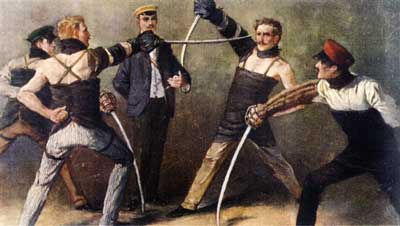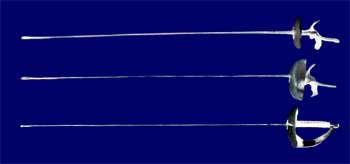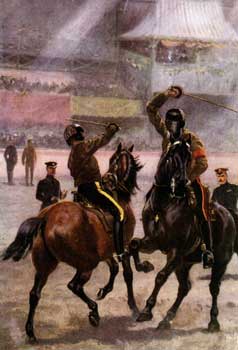

Fencing is the art of sword fighting, a tradition that stretches back hundreds of years having been practised as both a skill for killing and as a sport. The sword has been termed the"Queen of Weapons", and has been viewed as a symbol of nobility and justice. Fencing has been called a noble art and a science, It has been also likened to physical chess.
Modern fencing has evolved into three basic weapons: the foil, the épée and the sabre

The foil began life as a training weapon for the rapier, the épée has descended from the traditional duelling weapon. Both score with a direct hit using the point. The sabre has evolved from naval cutlasses and cavalry sabres, hits are scored using both the point and the cutting edge. All three weapons pursue a natural, quicker style of play than the heavy armour-busting broadswords of old.

Sabre is the only weapon that is fenced at NLSC.
The modern sabre can be traced back to the sleek, curved arabian scimitar, introduced to Europe as a result of contact with between Hungarian tribesmen and Turkish invaders during the 16th century. The sabre was then spread throughout the western world by the Hungarians, who by the 18th century had adopted it as their national sword. By the mid-18th century, more than 80 percent of all European swords were of the sabre design.
The sabre of this period was a broad heavy weapon that did not lend itself to intricate usage. It was in essence a hacking tool, although the point could be brought into play. Even the hand guard might be employed across the face of the enemy. The strongest significance of the sabre, with its cutting edge, was that it could be utilised more readily on horseback than a point weapon. In a melee - with soldiers finding themselves packed horse against horse - the cut was definitley far superior to the thrust.
Even so, 18th century duelists scorned the sabre as a crude implement, unfit for gentlemen, preferring instead the deadly small sword.
But the sabre couldn't be denied, it presented too many possibilities as a weapon of skill. In the early 19th century it was finally accepted into the sporting world. The early sport sabre closely resembled it's ponderous military counterpart. The bout produced was rather slow, especially when compared to foil; and because hits from the heavy blade caused discomfort, it became considered a real man's weapon.
By the latter part of the 19th century, the sabre had been streamlined to permit a new stylish and energetic style developed by the Italians, with swift cuts delivered by the hand and forearm with the elbow acting as a pivot point. The weapon became more popular, despite being scorned by the traditional sabre users.
While fast becoming a weapon of sport, as late as 1908, sabre was still touted as a weapon of war. In the opening days of World War I, soldiers carried sabres into battle; however, against machine guns, swords proved to be of little use and were quickly discarded.
The Hungarians, in 1851, began to develop the style that has supplanted all other approaches to the sabre. Blade control comes from the fingers and a flexible wrist. Wide arm movements are discouraged. Much importance is also placed on footwork, timing, mobility and tactics.
The sabre is both a cutting weapon and a point weapon, hits being scored primarily with the cutting edge of the blade. The sabre is a conventional weapon whereby it has rules of priority and a limited target area. The target area reflects the available target area of an opponent on horseback - all body parts (except the hand) from the waist up (there would be little point striking your adversary on the leg if you were fighting on horseback). Priority is given to the attacker who initially straightens his arm and continuously threatens the target with the point or the cutting edge. The president decides which fencer has priority if both sides register a simultaneous hit.